Briefing Report: HRM Strategies for Staff Development and Training
VerifiedAdded on 2023/01/11
|6
|1299
|62
Report
AI Summary
This report is a briefing report created for the HRM department of a UK-based customer service organization with 3000 employees, addressing declining profitability, productivity, and customer satisfaction. The report explores the need for a systematic staff development approach to improve employee skills and address high staff turnover. It covers various training methods, including on-the-job training and job rotation, along with their advantages and disadvantages. The report also discusses how to address different learning styles, the budgeting considerations, internal and external factors impacting implementation, and examples of successful implementation by other organizations. It concludes by summarizing the key reasons for adopting a systematic training approach, emphasizing improved skills, achievement of organizational goals, and enhanced employee expertise. The report includes references to relevant books and journals.

Briefing Report -HR
Paraphrase This Document
Need a fresh take? Get an instant paraphrase of this document with our AI Paraphraser
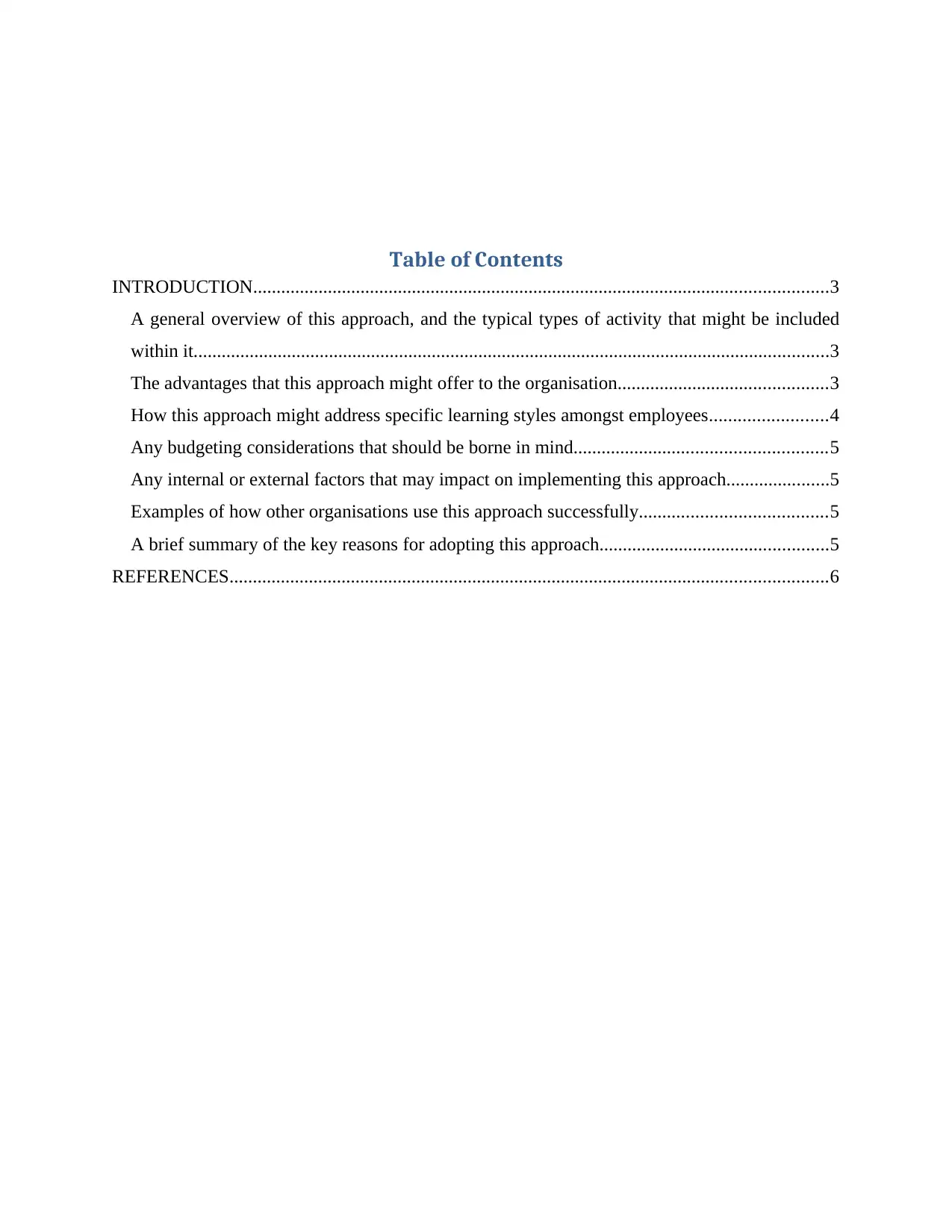
Table of Contents
INTRODUCTION...........................................................................................................................3
A general overview of this approach, and the typical types of activity that might be included
within it........................................................................................................................................3
The advantages that this approach might offer to the organisation.............................................3
How this approach might address specific learning styles amongst employees.........................4
Any budgeting considerations that should be borne in mind......................................................5
Any internal or external factors that may impact on implementing this approach......................5
Examples of how other organisations use this approach successfully........................................5
A brief summary of the key reasons for adopting this approach.................................................5
REFERENCES................................................................................................................................6
INTRODUCTION...........................................................................................................................3
A general overview of this approach, and the typical types of activity that might be included
within it........................................................................................................................................3
The advantages that this approach might offer to the organisation.............................................3
How this approach might address specific learning styles amongst employees.........................4
Any budgeting considerations that should be borne in mind......................................................5
Any internal or external factors that may impact on implementing this approach......................5
Examples of how other organisations use this approach successfully........................................5
A brief summary of the key reasons for adopting this approach.................................................5
REFERENCES................................................................................................................................6
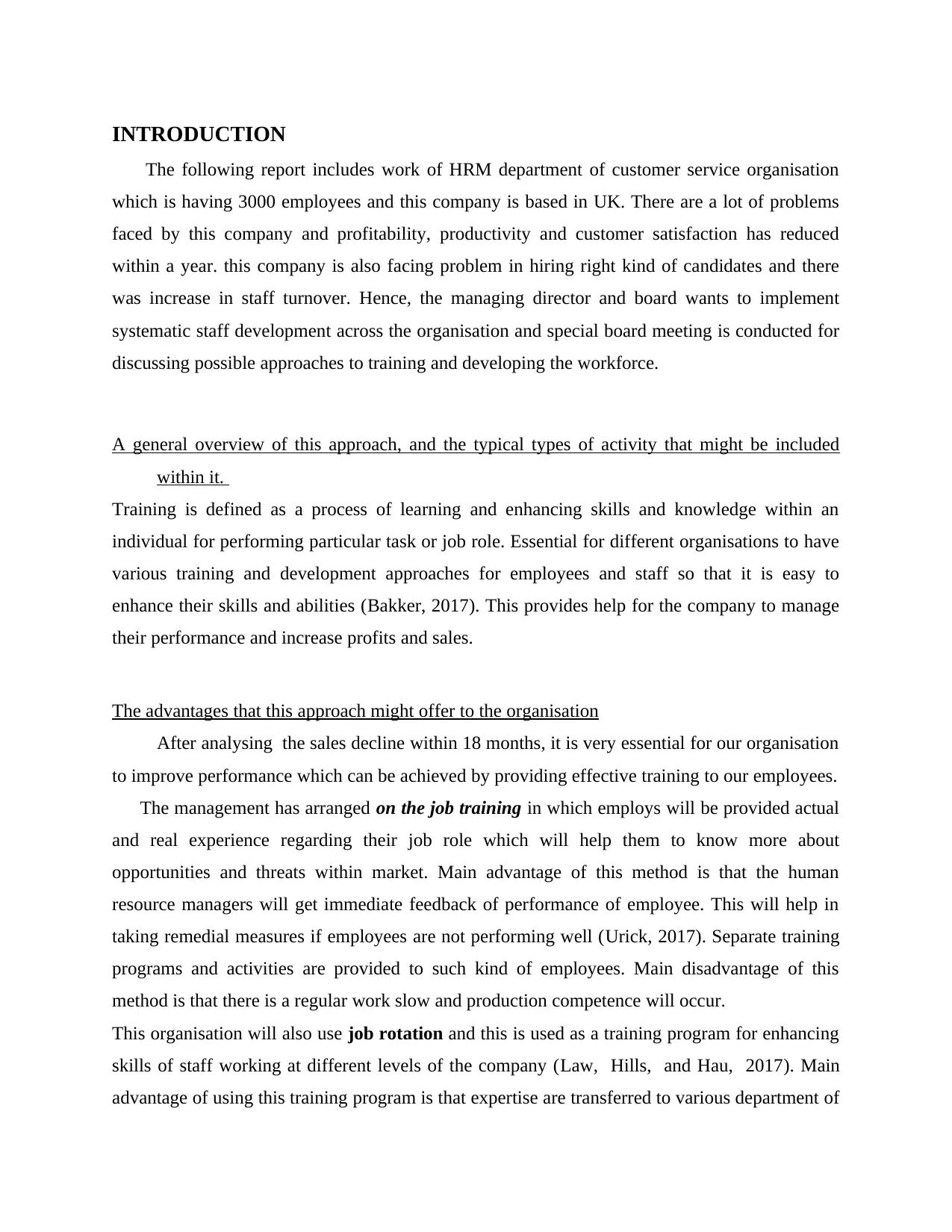
INTRODUCTION
The following report includes work of HRM department of customer service organisation
which is having 3000 employees and this company is based in UK. There are a lot of problems
faced by this company and profitability, productivity and customer satisfaction has reduced
within a year. this company is also facing problem in hiring right kind of candidates and there
was increase in staff turnover. Hence, the managing director and board wants to implement
systematic staff development across the organisation and special board meeting is conducted for
discussing possible approaches to training and developing the workforce.
A general overview of this approach, and the typical types of activity that might be included
within it.
Training is defined as a process of learning and enhancing skills and knowledge within an
individual for performing particular task or job role. Essential for different organisations to have
various training and development approaches for employees and staff so that it is easy to
enhance their skills and abilities (Bakker, 2017). This provides help for the company to manage
their performance and increase profits and sales.
The advantages that this approach might offer to the organisation
After analysing the sales decline within 18 months, it is very essential for our organisation
to improve performance which can be achieved by providing effective training to our employees.
The management has arranged on the job training in which employs will be provided actual
and real experience regarding their job role which will help them to know more about
opportunities and threats within market. Main advantage of this method is that the human
resource managers will get immediate feedback of performance of employee. This will help in
taking remedial measures if employees are not performing well (Urick, 2017). Separate training
programs and activities are provided to such kind of employees. Main disadvantage of this
method is that there is a regular work slow and production competence will occur.
This organisation will also use job rotation and this is used as a training program for enhancing
skills of staff working at different levels of the company (Law, Hills, and Hau, 2017). Main
advantage of using this training program is that expertise are transferred to various department of
The following report includes work of HRM department of customer service organisation
which is having 3000 employees and this company is based in UK. There are a lot of problems
faced by this company and profitability, productivity and customer satisfaction has reduced
within a year. this company is also facing problem in hiring right kind of candidates and there
was increase in staff turnover. Hence, the managing director and board wants to implement
systematic staff development across the organisation and special board meeting is conducted for
discussing possible approaches to training and developing the workforce.
A general overview of this approach, and the typical types of activity that might be included
within it.
Training is defined as a process of learning and enhancing skills and knowledge within an
individual for performing particular task or job role. Essential for different organisations to have
various training and development approaches for employees and staff so that it is easy to
enhance their skills and abilities (Bakker, 2017). This provides help for the company to manage
their performance and increase profits and sales.
The advantages that this approach might offer to the organisation
After analysing the sales decline within 18 months, it is very essential for our organisation
to improve performance which can be achieved by providing effective training to our employees.
The management has arranged on the job training in which employs will be provided actual
and real experience regarding their job role which will help them to know more about
opportunities and threats within market. Main advantage of this method is that the human
resource managers will get immediate feedback of performance of employee. This will help in
taking remedial measures if employees are not performing well (Urick, 2017). Separate training
programs and activities are provided to such kind of employees. Main disadvantage of this
method is that there is a regular work slow and production competence will occur.
This organisation will also use job rotation and this is used as a training program for enhancing
skills of staff working at different levels of the company (Law, Hills, and Hau, 2017). Main
advantage of using this training program is that expertise are transferred to various department of
⊘ This is a preview!⊘
Do you want full access?
Subscribe today to unlock all pages.

Trusted by 1+ million students worldwide
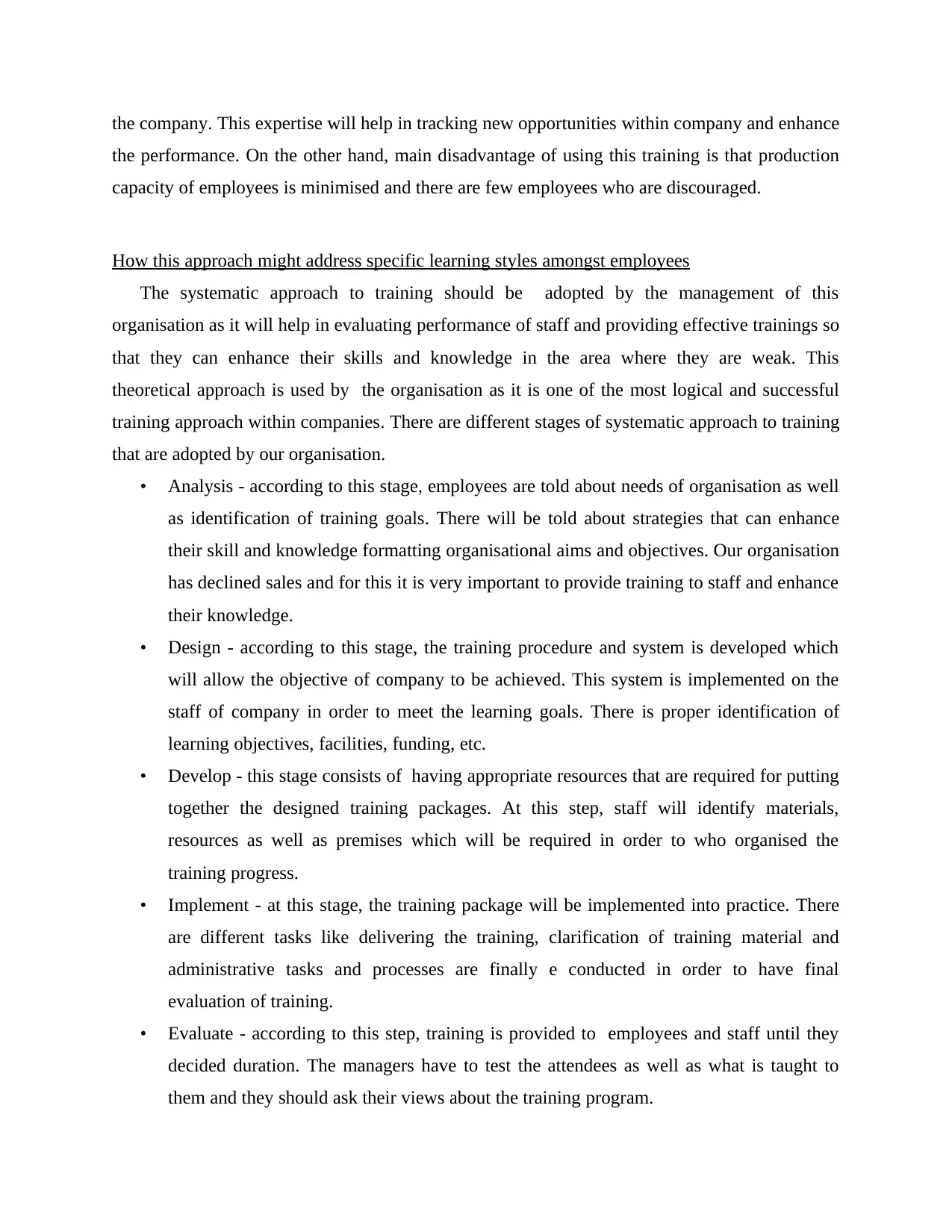
the company. This expertise will help in tracking new opportunities within company and enhance
the performance. On the other hand, main disadvantage of using this training is that production
capacity of employees is minimised and there are few employees who are discouraged.
How this approach might address specific learning styles amongst employees
The systematic approach to training should be adopted by the management of this
organisation as it will help in evaluating performance of staff and providing effective trainings so
that they can enhance their skills and knowledge in the area where they are weak. This
theoretical approach is used by the organisation as it is one of the most logical and successful
training approach within companies. There are different stages of systematic approach to training
that are adopted by our organisation.
• Analysis - according to this stage, employees are told about needs of organisation as well
as identification of training goals. There will be told about strategies that can enhance
their skill and knowledge formatting organisational aims and objectives. Our organisation
has declined sales and for this it is very important to provide training to staff and enhance
their knowledge.
• Design - according to this stage, the training procedure and system is developed which
will allow the objective of company to be achieved. This system is implemented on the
staff of company in order to meet the learning goals. There is proper identification of
learning objectives, facilities, funding, etc.
• Develop - this stage consists of having appropriate resources that are required for putting
together the designed training packages. At this step, staff will identify materials,
resources as well as premises which will be required in order to who organised the
training progress.
• Implement - at this stage, the training package will be implemented into practice. There
are different tasks like delivering the training, clarification of training material and
administrative tasks and processes are finally e conducted in order to have final
evaluation of training.
• Evaluate - according to this step, training is provided to employees and staff until they
decided duration. The managers have to test the attendees as well as what is taught to
them and they should ask their views about the training program.
the performance. On the other hand, main disadvantage of using this training is that production
capacity of employees is minimised and there are few employees who are discouraged.
How this approach might address specific learning styles amongst employees
The systematic approach to training should be adopted by the management of this
organisation as it will help in evaluating performance of staff and providing effective trainings so
that they can enhance their skills and knowledge in the area where they are weak. This
theoretical approach is used by the organisation as it is one of the most logical and successful
training approach within companies. There are different stages of systematic approach to training
that are adopted by our organisation.
• Analysis - according to this stage, employees are told about needs of organisation as well
as identification of training goals. There will be told about strategies that can enhance
their skill and knowledge formatting organisational aims and objectives. Our organisation
has declined sales and for this it is very important to provide training to staff and enhance
their knowledge.
• Design - according to this stage, the training procedure and system is developed which
will allow the objective of company to be achieved. This system is implemented on the
staff of company in order to meet the learning goals. There is proper identification of
learning objectives, facilities, funding, etc.
• Develop - this stage consists of having appropriate resources that are required for putting
together the designed training packages. At this step, staff will identify materials,
resources as well as premises which will be required in order to who organised the
training progress.
• Implement - at this stage, the training package will be implemented into practice. There
are different tasks like delivering the training, clarification of training material and
administrative tasks and processes are finally e conducted in order to have final
evaluation of training.
• Evaluate - according to this step, training is provided to employees and staff until they
decided duration. The managers have to test the attendees as well as what is taught to
them and they should ask their views about the training program.
Paraphrase This Document
Need a fresh take? Get an instant paraphrase of this document with our AI Paraphraser
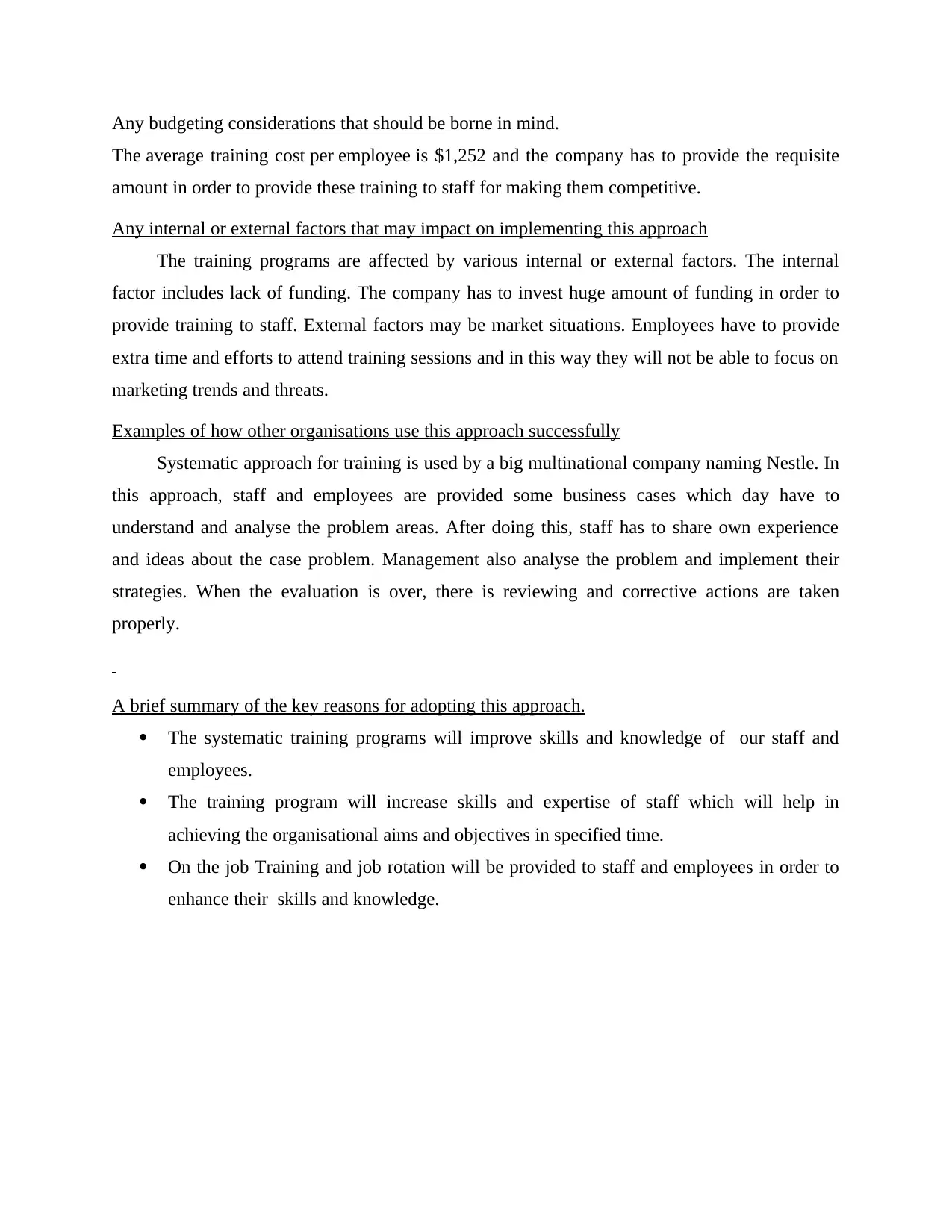
Any budgeting considerations that should be borne in mind.
The average training cost per employee is $1,252 and the company has to provide the requisite
amount in order to provide these training to staff for making them competitive.
Any internal or external factors that may impact on implementing this approach
The training programs are affected by various internal or external factors. The internal
factor includes lack of funding. The company has to invest huge amount of funding in order to
provide training to staff. External factors may be market situations. Employees have to provide
extra time and efforts to attend training sessions and in this way they will not be able to focus on
marketing trends and threats.
Examples of how other organisations use this approach successfully
Systematic approach for training is used by a big multinational company naming Nestle. In
this approach, staff and employees are provided some business cases which day have to
understand and analyse the problem areas. After doing this, staff has to share own experience
and ideas about the case problem. Management also analyse the problem and implement their
strategies. When the evaluation is over, there is reviewing and corrective actions are taken
properly.
A brief summary of the key reasons for adopting this approach.
The systematic training programs will improve skills and knowledge of our staff and
employees.
The training program will increase skills and expertise of staff which will help in
achieving the organisational aims and objectives in specified time.
On the job Training and job rotation will be provided to staff and employees in order to
enhance their skills and knowledge.
The average training cost per employee is $1,252 and the company has to provide the requisite
amount in order to provide these training to staff for making them competitive.
Any internal or external factors that may impact on implementing this approach
The training programs are affected by various internal or external factors. The internal
factor includes lack of funding. The company has to invest huge amount of funding in order to
provide training to staff. External factors may be market situations. Employees have to provide
extra time and efforts to attend training sessions and in this way they will not be able to focus on
marketing trends and threats.
Examples of how other organisations use this approach successfully
Systematic approach for training is used by a big multinational company naming Nestle. In
this approach, staff and employees are provided some business cases which day have to
understand and analyse the problem areas. After doing this, staff has to share own experience
and ideas about the case problem. Management also analyse the problem and implement their
strategies. When the evaluation is over, there is reviewing and corrective actions are taken
properly.
A brief summary of the key reasons for adopting this approach.
The systematic training programs will improve skills and knowledge of our staff and
employees.
The training program will increase skills and expertise of staff which will help in
achieving the organisational aims and objectives in specified time.
On the job Training and job rotation will be provided to staff and employees in order to
enhance their skills and knowledge.
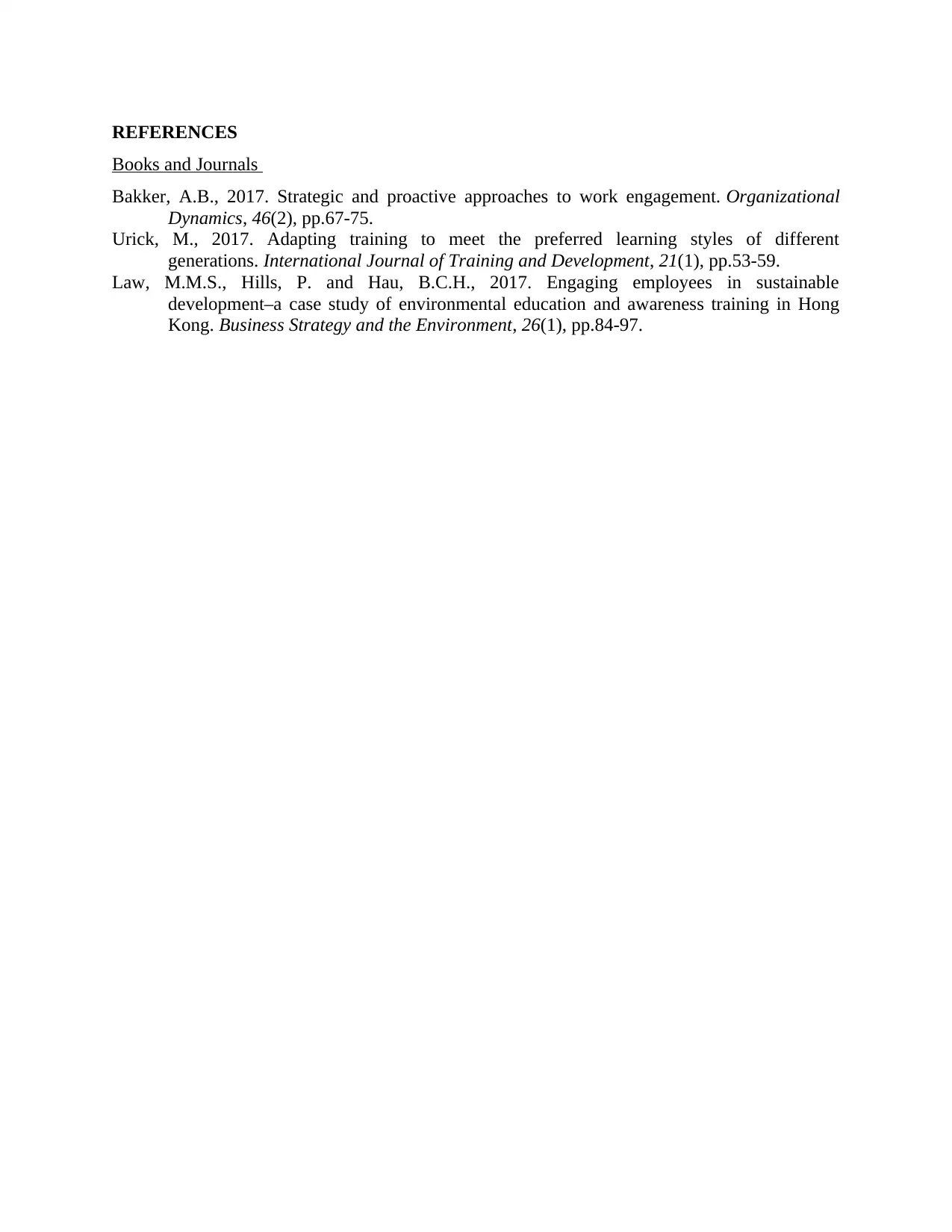
REFERENCES
Books and Journals
Bakker, A.B., 2017. Strategic and proactive approaches to work engagement. Organizational
Dynamics, 46(2), pp.67-75.
Urick, M., 2017. Adapting training to meet the preferred learning styles of different
generations. International Journal of Training and Development, 21(1), pp.53-59.
Law, M.M.S., Hills, P. and Hau, B.C.H., 2017. Engaging employees in sustainable
development–a case study of environmental education and awareness training in Hong
Kong. Business Strategy and the Environment, 26(1), pp.84-97.
Books and Journals
Bakker, A.B., 2017. Strategic and proactive approaches to work engagement. Organizational
Dynamics, 46(2), pp.67-75.
Urick, M., 2017. Adapting training to meet the preferred learning styles of different
generations. International Journal of Training and Development, 21(1), pp.53-59.
Law, M.M.S., Hills, P. and Hau, B.C.H., 2017. Engaging employees in sustainable
development–a case study of environmental education and awareness training in Hong
Kong. Business Strategy and the Environment, 26(1), pp.84-97.
⊘ This is a preview!⊘
Do you want full access?
Subscribe today to unlock all pages.

Trusted by 1+ million students worldwide
1 out of 6
Related Documents
Your All-in-One AI-Powered Toolkit for Academic Success.
+13062052269
info@desklib.com
Available 24*7 on WhatsApp / Email
![[object Object]](/_next/static/media/star-bottom.7253800d.svg)
Unlock your academic potential
Copyright © 2020–2025 A2Z Services. All Rights Reserved. Developed and managed by ZUCOL.





